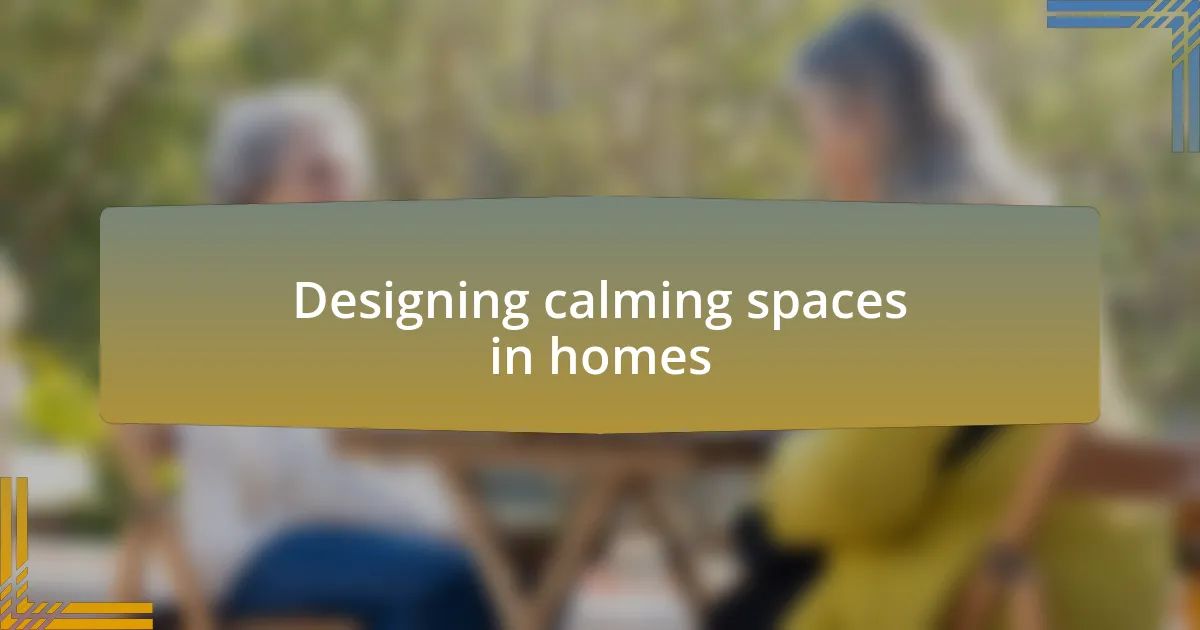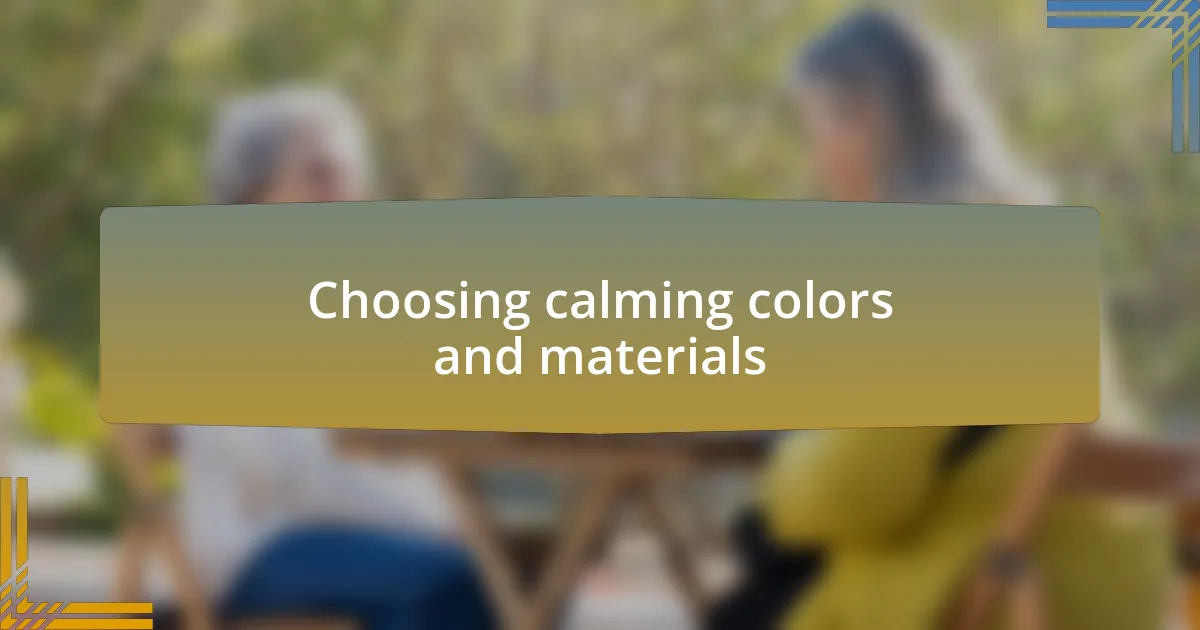Key takeaways:
- A calm environment promotes overall well-being and mental health by reducing stress and encouraging mindfulness.
- Key elements of tranquility include soft lighting, natural elements, soothing sounds, and thoughtful color choices.
- Personalization, such as incorporating meaningful textures, colors, and memories, significantly enhances the calming effect of a space.
- Design strategies like decluttering and using natural materials can transform spaces into serene retreats.

Understanding a calm environment
Creating a calm environment is about more than just aesthetics; it’s about the feelings and sensations that space evokes. I often think back to a quiet afternoon spent in a softly lit room, where the gentle sound of water trickling from a small fountain made everything feel tranquil. Have you ever noticed how the right atmosphere can soothe your mind, pulling you into a state of blissful relaxation?
To truly understand calmness, we must consider the role of sensory experiences. I remember a time when I entered a room filled with the warm scent of vanilla and lavender; it instantly took away my stress. The calming effect of natural elements—like plants or soft textiles—can significantly enhance one’s emotional state. Isn’t it fascinating how such simple details can impact our mood so profoundly?
Moreover, a calm environment encourages mindfulness, allowing us to pause and appreciate the present moment. I find that when I’m surrounded by serene colors and minimal clutter, it becomes easier to reflect and find clarity. What elements would you incorporate into your daily space to help cultivate that same sense of peace? Considering it can inspire you to create your own oasis of serenity.

Importance of a calm environment
A calm environment is vital for promoting overall well-being, especially as we navigate the changes that come with aging. I recall a serene evening spent on my patio, surrounded by the soft rustling of leaves and gentle twilight hues. It struck me how that peaceful setting provided a sense of safety and comfort, making the burdens of the day feel lighter. Have you ever found that being in a tranquil space helped you let go of stress from your daily life?
The influence of calmness extends beyond personal comfort; it plays a significant role in mental health. I remember when a close friend struggled with anxiety. Creating a cozy nook filled with soft lighting and plush pillows transformed her mindset. In such spaces, stress dissipates, allowing clarity and focus to take center stage. Isn’t it amazing how even small changes in our environment can facilitate emotional healing and resilience?
Lastly, a calm environment fosters meaningful connections with others. Reflecting on gatherings in my quiet living room, I realize how the tranquil backdrop encouraged heartfelt conversations. The absence of chaos allows us to engage deeply with loved ones, creating bonds that enrich our lives. How can you rearrange your space to invite more tranquility and connection?

Elements of a calm environment
One crucial element of a calm environment is lighting. I’ve found that soft, warm lighting can set an inviting mood. I still remember switching to dimmable lamps and how it instantly changed the atmosphere in my living room. It was like wrapping myself in a gentle embrace each evening. How have your lighting choices impacted your feelings of serenity?
Another important aspect is the use of natural elements. I often incorporate plants into my spaces. Not only do they freshen the air, but they also bring a sense of life and peace. I once visited a friend who had a small indoor garden, and the sense of tranquility it created was palpable. I could almost feel my stress melting away just by being there. Have you thought about inviting nature indoors to enhance your calm sanctuary?
Finally, sound plays a vital role in creating a serene atmosphere. My favorite way to wind down is by playing soft music or nature sounds. I recall a weekend spent listening to gentle rain while curled up with a good book; it was pure bliss. Sound has a profound ability to influence mood, doesn’t it? How could you incorporate soothing sounds into your living space to enrich your daily experience?

Designing calming spaces in homes
When designing calming spaces, color choice plays an integral role in setting the tone. I’ve always been drawn to soft, muted tones like pale blues and gentle greens; they seem to envelop the senses and promote relaxation. I vividly recall painting my bedroom a tranquil shade of lavender, and the transformation was remarkable—it felt as if the room itself exhaled. Which colors make you feel most at peace in your own home?
Furniture selection also influences the overall ambiance. I’ve learned that opting for comfortable, understated pieces fosters a sense of ease. I once swapped a rigid chair for a plush armchair that hugged my body just right. Now, curling up with a book in that cozy corner feels like a luxury. Have you considered how the softness or shape of your furnishings impacts your comfort?
The arrangement of space is equally crucial. I’ve discovered that decluttering and creating open areas can dramatically enhance the feeling of calm. After clearing away unnecessary items, I felt a weight lift—suddenly, the room felt expansive and airy. It’s interesting how the space around us shapes our mental landscape, isn’t it? How can you reimagine your environment to breathe new life into your calming spaces?

Choosing calming colors and materials
Choosing colors and materials can drastically influence the serenity of a space. When redesigning my living room, I decided to incorporate earthy neutrals paired with rich textures. The addition of a soft beige couch and natural wood accents created a comforting embrace, transporting me to a cozy retreat every time I walked in. Have you thought about how the textures around you might evoke a sense of calm?
For me, the right shade can transform an entire room. After experimenting, I realized that a pale aqua not only brightened my home office but also brought a sense of tranquility that helped me focus. It’s intriguing to reflect on how colors can almost converse with our emotions, isn’t it? I often wonder what specific hues whisper peace to you in your own environment.
Choosing the right materials can also significantly contribute to a calm atmosphere. I remember replacing cold, hard tiles with plush carpets, which instantly softened the room. As I sank my toes into the fabric, a wave of relaxation washed over me, emphasizing how tactile choices can promote comfort and peace. What materials do you find most comforting in your everyday life?

Incorporating nature into living areas
Incorporating nature into living areas can truly enhance the peacefulness of a space. For instance, I decided to place potted plants throughout my home, which transformed my environment. There’s something incredibly soothing about watching a small fern sway gently in the breeze—it connects me to the outside world even when I’m indoors. Have you noticed how a little greenery can uplift your mood?
In my experience, large, airy windows that overlook gardens or scenic views can create a seamless transition between indoors and outdoors. I once spent hours captivated by the changing colors of the leaves outside, which made my living room feel alive and dynamic. I can’t help but think, how does natural light affect your sense of calm?
Lastly, integrating natural materials into furniture and decor has also been a significant step for me. I replaced synthetic pieces with items made from bamboo and reclaimed wood, and the warmth they emit is unmistakable. It reminds me of my childhood spent in my grandfather’s cabin—everything felt more grounded and harmonious there. Doesn’t it feel wonderful to surround ourselves with materials that reflect nature’s beauty?

Personalizing your calming environment
Personalizing your calming environment starts with understanding what truly resonates with you. For me, incorporating soft textures has made a significant difference. I remember when I added a plush, handwoven rug to my living room; it felt like stepping onto a cloud every time I entered. Have you ever noticed how a cozy texture can instantly ease tension and invite you to unwind?
Moreover, I’ve found that using colors in a way that speaks to my emotions elevates my space. Soft blues and gentle greens, reminiscent of the ocean and forests, tend to calm my mind. When I painted my bedroom walls a light sage, it felt as though I was enveloped in nature itself, creating an ambiance that encourages restful nights. What colors bring you a sense of peace?
Lastly, I believe that personal memories play a pivotal role in shaping our tranquil spaces. For instance, I’ve displayed photographs of cherished moments, like my travels abroad. Each image sparks a story and a smile, reminding me of joy and adventure. Doesn’t it feel like a piece of your heart comes alive when you surround yourself with what you love?